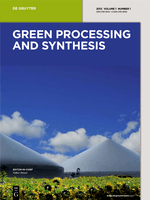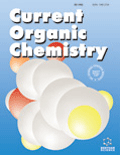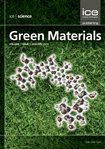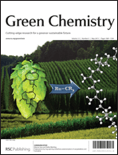
Green Processing and Synthesis
Scope & Guideline
Championing Research for a Greener Planet
Introduction
Aims and Scopes
- Green Synthesis of Nanomaterials:
The journal consistently publishes research on the green synthesis of various nanomaterials using plant extracts, microorganisms, and other eco-friendly methods, highlighting their potential applications in medicine, agriculture, and environmental remediation. - Biological and Environmental Applications:
Research often emphasizes the biological activities of synthesized materials, such as antimicrobial, antioxidant, and anticancer properties, showcasing their applications in health and environmental sectors. - Waste Valorization and Resource Recovery:
The journal includes studies on the valorization of agricultural and industrial waste materials for the synthesis of valuable products, promoting sustainable practices in resource recovery. - Innovative Characterization Techniques:
Papers frequently introduce novel characterization methods for synthesized materials, enhancing understanding of their properties and functionalities for specific applications. - Process Optimization and Methodology Development:
The journal features articles on optimizing synthesis processes, often employing statistical methods and innovative technologies like microwave-assisted synthesis to improve efficiency and reduce waste.
Trending and Emerging
- Eco-Friendly Nanocomposites:
Recent publications highlight the development of eco-friendly nanocomposites that combine sustainable materials with nanotechnology for enhanced properties, particularly in biomedical and environmental applications. - Nanotechnology in Agriculture:
There is a rising trend in research exploring the application of nanotechnology for sustainable agricultural practices, including the use of nanofertilizers and nanopesticides to improve crop yield and reduce chemical inputs. - Circular Economy Practices:
Emerging studies focus on circular economy principles, emphasizing the recycling and repurposing of materials to create closed-loop systems in chemical processing and material synthesis. - Phytochemicals in Synthesis:
The use of phytochemicals extracted from plants for the green synthesis of nanoparticles and other materials is gaining traction, reflecting a broader interest in utilizing natural resources for sustainable innovations. - Advanced Photocatalytic Materials:
Research on photocatalytic materials for environmental remediation, particularly for the degradation of pollutants and dyes, is increasingly prominent, showcasing their potential in addressing global environmental challenges.
Declining or Waning
- Traditional Chemical Synthesis Methods:
There is a noticeable decline in publications focusing on conventional chemical synthesis methods, as researchers increasingly prioritize greener alternatives that minimize environmental impact. - Non-Biological Nanomaterials:
The focus on non-biologically derived nanomaterials has decreased, with a growing preference for biogenic synthesis methods that utilize natural resources and processes. - Conventional Analytical Techniques:
Fewer papers are based on traditional analytical techniques for characterizing nanomaterials, as the field shifts towards more advanced and environmentally friendly characterization methods. - Single-Use Plastics and Non-Biodegradable Materials:
Research on the synthesis and application of non-biodegradable materials is declining, aligning with global trends towards sustainability and the reduction of plastic waste. - Standardized Chemical Processes:
There is a diminishing interest in standardized chemical processes that do not incorporate sustainability metrics, as the journal emphasizes green innovations and tailored, eco-friendly approaches.
Similar Journals

CURRENT ORGANIC CHEMISTRY
Fostering Excellence in Organic Chemistry ScholarshipCURRENT ORGANIC CHEMISTRY, published by Bentham Science Publishers, stands as a pivotal platform in the field of organic chemistry, providing innovative insights and advancements since its inception in 1997. With an ISSN of 1385-2728 and an E-ISSN of 1875-5348, this esteemed journal has carved a niche in the academic landscape, currently ranking in the Q3 category for Organic Chemistry according to the 2023 metrics. Operating from the United Arab Emirates, it engages a diverse audience of researchers, professionals, and students by delivering quality peer-reviewed articles that cover a broad spectrum of organic chemistry research. Although the journal does not offer open access, it remains a respected source of knowledge, indexed in Scopus with a percentile ranking of 43, encouraging rigorous discourse and the dissemination of cutting-edge findings. With continuous publication through 2024, CURRENT ORGANIC CHEMISTRY is dedicated to advancing the frontiers of organic chemistry research and technology.

Sustainable Chemistry and Pharmacy
Bridging Chemistry and Pharmacy for a Sustainable TomorrowSustainable Chemistry and Pharmacy is an esteemed journal published by ELSEVIER, positioned at the intersection of chemistry and pharmacy with a robust focus on sustainability. Operating from the Netherlands, this journal serves as a crucial platform for disseminating innovative research and advanced practices in Pharmaceutical Sciences, Environmental Chemistry, and Pollution Management. With its impressive performance, it is ranked Q1 in Pharmaceutical Science and Pollution and Q2 in both Environmental Chemistry and Management, Monitoring, Policy and Law, with significant rankings in Scopus, reflecting an influential footprint in the academic community. As an Open Access subscription-based journal with a reader-friendly policy, it aims to provide researchers, professionals, and students with access to critical insights and cutting-edge methodologies that could shape future practices and policies in sustainability. Established in 2015 and projected forward to 2024, the journal plays a pivotal role in addressing contemporary environmental challenges while fostering a bridge between chemical sciences and pharmaceutical innovation.

INDIAN JOURNAL OF HETEROCYCLIC CHEMISTRY
Advancing Knowledge in Heterocyclic ChemistryINDIAN JOURNAL OF HETEROCYCLIC CHEMISTRY, published by CONNECT JOURNALS, is a vital resource in the fields of organic chemistry and biochemistry, aiming to advance research and promote innovation within the realm of heterocyclic compounds. Established in 1996, this journal has successfully converged into an influential publication with a commitment to disseminating high-quality, peer-reviewed research articles that enhance the understanding of heterocyclic chemistry applications. Although it currently holds a Q4 quartile ranking in both biochemistry and organic chemistry according to the 2023 categorizations, its broader contributions to the scientific community should not be underestimated, as it seeks to support the ongoing dialogue among researchers, professionals, and students. The journal operates from Ghaziabad, India, providing open access to its publications, thereby fostering a collaborative and informative environment for its international readership. With an ISSN of 0971-1627 and a special focus on contemporary challenges and developments in the field, the INDIAN JOURNAL OF HETEROCYCLIC CHEMISTRY is poised to make a significant impact as it continues to evolve through 2024 and beyond.

Ceramics-Switzerland
Elevating Research Standards in Materials ScienceCeramics-Switzerland is a prominent open-access journal published by MDPI, dedicated to advancing knowledge in the field of ceramics and materials science. Established in 2018, this journal serves as a vital platform for researchers, professionals, and students to disseminate innovative research and technology in ceramics and composites. With an impressive impact factor and a categorized ranking of Q2 in Ceramics and Composites and Q3 in Miscellaneous Materials Science for 2023, Ceramics-Switzerland signifies its growing influence and contribution to the scientific community. The journal is indexed in Scopus, where it boasts a rank that highlights its competitive standing within the field. Being an open access journal enables the wide distribution of research findings, fostering greater collaboration and knowledge sharing among scholars and industry experts globally.

CCS Chemistry
Connecting Researchers with Cutting-Edge Chemical InsightsCCS Chemistry, published by the esteemed Chinese Chemical Society, is a leading open-access journal dedicated to advancing the field of chemistry. Since its inception in 2019, the journal has rapidly gained recognition, achieving a remarkable impact factor that places it in the prestigious Q1 category in Chemistry (Miscellaneous) as of 2023. With a Scopus ranking of #41 out of 408 in General Chemistry, CCS Chemistry represents the top 10th percentile in its category, reflecting its commitment to high-quality research and innovation. The journal serves as a vital platform for researchers and professionals to share their findings, showcase cutting-edge methodologies, and engage with the latest developments in various chemistry subfields. Accessible to a global audience, CCS Chemistry ensures that groundbreaking research is available without barriers, making it an indispensable resource for students and academics aiming to stay at the forefront of chemical sciences. For further details, submissions, and access to published articles, please visit the journal's website.

RUSSIAN CHEMICAL BULLETIN
Connecting Researchers through Pioneering Chemical Insights.RUSSIAN CHEMICAL BULLETIN, published by SPRINGER, serves as a pivotal resource in the field of general chemistry, covering a wide array of topics that impact both theoretical and applied chemistry. With an ISSN of 1066-5285 and a presence since 1993, this journal provides a platform for disseminating significant research findings, practical applications, and novel methodologies within the broader chemistry community. While it currently holds a Q3 ranking in the Chemistry (miscellaneous) category and occupies the 230th position out of 408 in the Scopus rankings, its reputation continues to grow, fostering collaboration and innovation among researchers and professionals alike. Although the journal does not offer an open-access model, it is committed to making findings accessible within the academic community, ensuring that valuable insights can inform future research. With an anticipated convergence of studies extending to 2024, the RUSSIAN CHEMICAL BULLETIN remains an essential reference for those dedicated to advancing chemical science.

HETEROCYCLIC COMMUNICATIONS
Connecting Scholars in Heterocyclic ScienceHeterocyclic Communications, published by De Gruyter Poland Sp. z o.o., is a leading open-access journal dedicated to the field of organic chemistry. With its ISSN 0793-0283 and E-ISSN 2191-0197, this journal has been disseminating significant research findings since its inception in 1994, and continues to contribute to the scientific community through 2024. Based in Germany, Heterocyclic Communications occupies a reputable position, classified in the third quartile (Q3) of organic chemistry journals with a Scopus rank of #119 out of 211, indicating its growing influence in the field. The journal is committed to fostering scholarly communication and knowledge exchange among researchers, professionals, and students, providing a platform for innovative studies and insights into heterocyclic compounds and their applications. As an open-access journal since 2019, it ensures that valuable research is readily available to a global audience, enhancing collaboration and advancement in organic chemistry research.

Green Materials
Transforming challenges into sustainable material solutions.Green Materials, published by Emerald Group Publishing Ltd, serves as a crucial platform for research within the realm of sustainable materials science. Since its inception in 2013, this journal has focused on addressing pressing global challenges, particularly in Materials Chemistry, Pollution, and Polymers and Plastics, as evidenced by its rankings within the Q3 Quartiles. With a commitment to high-quality, peer-reviewed content, it caters to an audience keen on innovative solutions that promote environmental sustainability. Researchers and professionals can access a wealth of knowledge and insights that are instrumental in advancing the field, despite the absence of an open-access option. As the journal continues to converge towards its projected endpoint in 2024, it remains a vital resource for those dedicated to exploring the intersection of materials science and ecological responsibility, ensuring its relevance in academic discussions and practical applications.

Eurasian Journal of Chemistry
Fostering Collaboration Through Open AccessEurasian Journal of Chemistry is an emerging open-access journal published by KARAGANDA STATE UNIVERSITY in Kazakhstan. With a focus on the diverse and dynamic field of chemistry, this journal aims to disseminate cutting-edge research and innovative findings from various branches of chemistry, engaging a global audience of researchers, professionals, and students. Despite its recent inception in 2023, the journal is strategically positioned within the field, currently ranked in the fourth quartile of Scopus for General Chemistry, indicating its potential for growth and contribution to the scientific community. The ISSN of the journal is 2959-0663 with an electronic counterpart of 2959-0671, ensuring wide accessibility to its rich content. With an open-access model, the Eurasian Journal of Chemistry promotes the sharing of knowledge and advances in research to foster collaboration and inspiration across the globe.

GREEN CHEMISTRY
Leading the charge in sustainable chemistry and pollution studies.GREEN CHEMISTRY, published by the prestigious Royal Society of Chemistry, stands at the forefront of the rapidly evolving field of sustainable chemistry. Since its inception in 1999, this esteemed journal has consistently made significant contributions to environmental chemistry and pollution studies, achieving an impressive Q1 ranking in both categories as of 2023. With a distinguished presence in Scopus rankings, positioned at #10 in Environmental Science _ Pollution and #12 in Environmental Science _ Environmental Chemistry, GREEN CHEMISTRY is recognized for its commitment to advancing research that prioritizes eco-friendly practices and innovative methodologies. The journal serves as a vital platform for researchers and professionals dedicated to promoting sustainability and reducing environmental impact through chemistry, making it an essential resource for anyone interested in the intersection of chemistry and environmental sciences. Although it does not currently offer open access, its significant impact factor highlights its relevance and authority in the field. The journal is located at Thomas Graham House, Science Park, Milton Road, Cambridge, UK, and continues to engage a global audience of scientists and students passionate about green innovations.